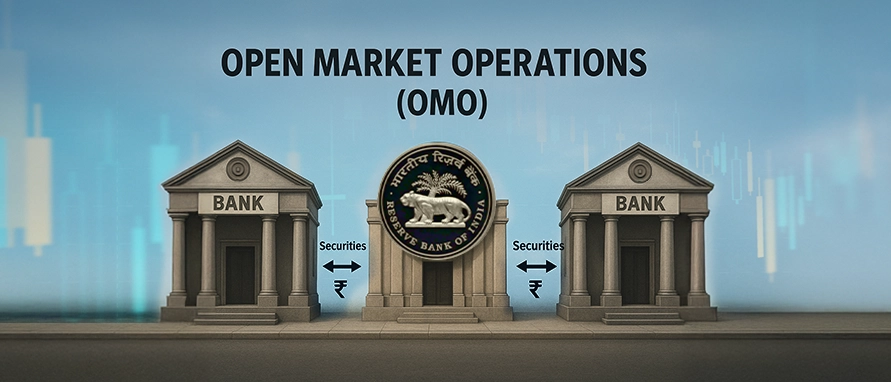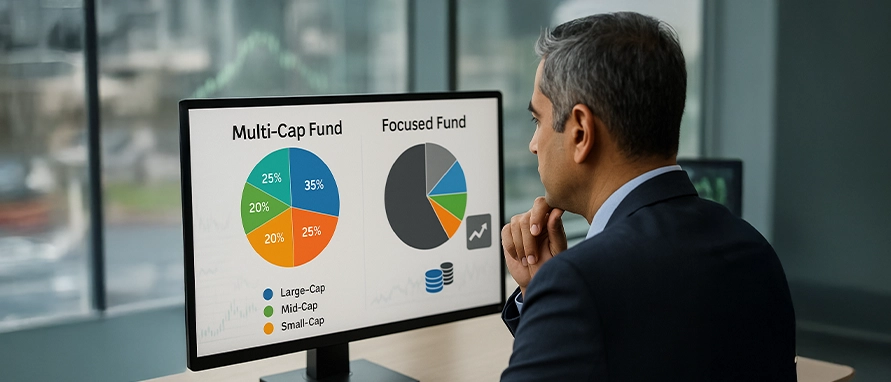-
Our ProductsLoansCardsInsuranceInvestmentsStock MarketElectronics MallCIBIL ScoreKnowledge CentreAcademyCalculators
- Our Services
- My Account
- Discover
How Did the IL&FS Crisis Trigger Panic in the Indian Market
The IL&FS (Infrastructure Leasing & Financial Services) crisis, which came to light in 2018, was a pivotal moment for the Indian financial system. A reputed infrastructure financing company defaulting on its debt obligations sent shockwaves across the financial sector, particularly in non-banking financial companies (NBFCs) and mutual funds. The default not only led to panic in debt and equity markets but also sparked a broader conversation about risk management, regulatory oversight, and the health of India's shadow banking sector.
What Is IL&FS
IL&FS was incorporated in 1987 as an infrastructure development and finance company. Over the years, it became a key player in financing large-scale infrastructure projects across India, operating through a complex web of over 300 subsidiaries and joint ventures.
Despite being privately held, IL&FS had high-profile shareholders such as LIC, SBI, HDFC, and Central Bank of India, giving it credibility and access to low-cost funds. The company’s business model relied heavily on debt to fund long-gestation infrastructure projects.
What Triggered the Crisis
The crisis began when IL&FS started defaulting on its short-term debt obligations in mid-2018. The primary triggers included:
Liquidity mismatch: IL&FS borrowed short-term but lent long-term, creating a classic asset-liability mismatch.
Delays in project execution: Many of its infrastructure projects were delayed, leading to cost overruns and no revenue generation.
High debt burden: The group had an estimated consolidated debt of over ₹1 lakh crore, with very little cash flow.
Poor governance and opacity: Lack of financial transparency and corporate governance failures played a major role.
When the company failed to meet repayments, credit rating agencies downgraded its instruments, further eroding investor trust.
Immediate Impact on Financial Markets
The IL&FS default was not an isolated event; it exposed deep vulnerabilities within the financial ecosystem:
1. Shock to NBFC Sector
NBFCs, many of which relied on short-term borrowing to lend long-term, faced a severe liquidity crunch. Lenders became risk-averse, making it difficult for even well-run NBFCs to raise funds.
2. Redemption Pressure on Mutual Funds
Mutual funds, especially debt funds, had significant exposure to IL&FS and other NBFCs. As panic spread, investors started pulling out, forcing funds to sell high-quality assets to meet redemptions, further destabilising the market.
3. Credit Market Freeze
The corporate bond market saw a dramatic spike in yields. Many NBFCs and housing finance companies (HFCs) found it hard to roll over their borrowings.
4. Equity Market Volatility
The fear of a systemic financial crisis led to sell-offs in stocks, especially those related to financial services, infrastructure, and real estate.
Regulatory and Government Response
The magnitude of the crisis prompted swift action from regulators and the government:
Government takeover: The National Company Law Tribunal (NCLT) allowed the government to replace the IL&FS board to restore governance.
Liquidity support: RBI and SEBI stepped in with liquidity measures to stabilise NBFCs and mutual funds.
Tighter regulations: Enhanced supervision of NBFCs was implemented, including stricter asset-liability management norms.
These actions helped contain the contagion and re-establish confidence in the financial system.
Long-Term Implications of the Crisis
The IL&FS fallout left a lasting imprint on how India views financial stability:
1. Improved Risk Assessment
Lenders and rating agencies have become more cautious. There's now greater focus on assessing the quality of assets, promoter strength, and transparency.
2. Consolidation in NBFC Space
The crisis led to a flight to quality. Stronger NBFCs grew while weaker ones struggled or exited the market.
3. Push for Better Governance
Corporate governance standards came under scrutiny, leading to stricter rules on disclosures, audits, and board responsibilities.
4. Restructuring of IL&FS
The resolution process aimed to monetise assets and repay debt. The group’s subsidiaries were auctioned or transferred under a court-monitored process.
Lessons for Investors and Policymakers
IL&FS crisis revealed key systemic lessons for markets:
Monitoring debt levels and repayment capacity
Transparency in corporate financials
Independent oversight and timely regulatory action
Diversification in mutual fund portfolios
It also served as a warning against complacency driven by brand reputation or ownership by reputed institutions.
Conclusion
The IL&FS crisis was more than just the collapse of a single company. It revealed systemic issues in India’s financial architecture, especially around NBFCs, risk evaluation, and regulatory supervision. While it caused short-term panic and losses, the crisis also triggered reforms that aimed to make the financial ecosystem more resilient and transparent.
Disclaimer
This content is for informational purposes only and the same should not be construed as investment advice. Bajaj Finserv Direct Limited shall not be liable or responsible for any investment decision that you may take based on this content.
FAQs
What caused the IL&FS crisis?
The IL&FS crisis was caused by a mix of liquidity mismatch, project delays, excessive debt, and weak governance, which ultimately led to defaults on debt obligations.
Which sectors were affected most by the crisis?
The IL&FS crisis had a severe impact on NBFCs, mutual funds, real estate, and infrastructure sectors, leading to liquidity crunches and market instability.
How did the government respond to the crisis?
The government responded to the IL&FS crisis by replacing the company’s board, initiating a court-monitored resolution process, and directing regulators to provide liquidity support along with revising risk management norms.
What was the impact on investors?
The IL&FS crisis negatively impacted investors, as many mutual fund holders faced losses or redemption freezes, while stock markets saw increased volatility and erosion of investor confidence.
Has IL&FS fully resolved its debt issues?
The IL&FS debt resolution is still ongoing, with the process involving phased asset sales and repayments that continue under regulatory and judicial supervision.
With a Postgraduate degree in Global Financial Markets from the Bombay Stock Exchange Institute, Nupur has over 8 years of experience in the financial markets, specializing in investments, stock market operations, and project management. She has contributed to process improvements, cross-functional initiatives & content development across investment products. She bridges investment strategy with execution, blending content insight, operational efficiency, and collaborative execution to deliver impactful outcomes.
Related Blogs

Geetanjali Lachke

Roshani Ballal

Geetanjali Lachke

Roshani Ballal

Roshani Ballal

Geetanjali Lachke

Geetanjali Lachke

Nupur Wankhede

Anshika

Nupur Wankhede

Nupur Wankhede

Nupur Wankhede

Nupur Wankhede

Nupur Wankhede

Nupur Wankhede

Geetanjali Lachke

Geetanjali Lachke

Roshani Ballal

Nupur Wankhede

Anshika

Anshika

Nupur Wankhede

Nupur Wankhede

Nupur Wankhede

Nupur Wankhede

Nupur Wankhede

Nupur Wankhede

Nupur Wankhede

Nupur Wankhede

Nupur Wankhede

Nupur Wankhede

Nupur Wankhede

Nupur Wankhede

Roshani Ballal

Anshika

Nupur Wankhede

Geetanjali Lachke

Roshani Ballal

Nupur Wankhede

Nupur Wankhede

Anshika

Anshika

Nupur Wankhede

Anshika

Anshika

Nupur Wankhede
.webp)
Nupur Wankhede

Nupur Wankhede

Nupur Wankhede

Nupur Wankhede

Nupur Wankhede

Nupur Wankhede

Nupur Wankhede
.webp)
Nupur Wankhede

Nupur Wankhede

Nupur Wankhede

Nupur Wankhede
-in-India.webp)
Nupur Wankhede

Nupur Wankhede

Nupur Wankhede

Anshika

Nupur Wankhede

Nupur Wankhede

Anshika

Anshika

Nupur Wankhede

Nupur Wankhede

Nupur Wankhede

Nupur Wankhede

Nupur Wankhede

Nupur Wankhede

Nupur Wankhede

Nupur Wankhede

Nupur Wankhede

Nupur Wankhede

Anshika

Nupur Wankhede

Nupur Wankhede

Nupur Wankhede

Nupur Wankhede

Anshika

Nupur Wankhede

Nupur Wankhede
-Meaning-Importance.webp)
Nupur Wankhede

Anshika

Nupur Wankhede

Nupur Wankhede

Nupur Wankhede

Anshika

Nupur Wankhede

Nupur Wankhede

Nupur Wankhede

Geetanjali Lachke

Geetanjali Lachke

Geetanjali Lachke

Anshika

Anshika

Nupur Wankhede

Nupur Wankhede
-portfolio.webp)
Nupur Wankhede

Anshika

Roshani Ballal

Geetanjali Lachke

Geetanjali Lachke

Geetanjali Lachke

Geetanjali Lachke

Geetanjali Lachke

Roshani Ballal

Roshani Ballal

Geetanjali Lachke

Geetanjali Lachke

Geetanjali Lachke

Roshani Ballal

Roshani Ballal

Geetanjali Lachke

Roshani Ballal

Roshani Ballal

Roshani Ballal

Roshani Ballal

Roshani Ballal

Roshani Ballal

Roshani Ballal

Roshani Ballal

Roshani Ballal





















































.webp)



.webp)











.webp)




.webp)




































